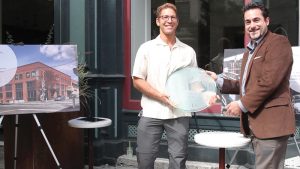Rating Systems Drive Systemic Change
In December 2021, the Wells Fargo Foundation made a $300,000 grant to the U.S. Resiliency Council (USRC), a nonprofit that develops natural hazard building performance rating systems. The grant is focused on USRC’s implementation of a rating system for buildings under straight-line wind and storm surge risks.
Rating systems related to energy and environmental impact are now plentiful and standard in the tool kit of design professionals. They have proved a powerful tool in popularizing sustainable design approaches and investment forward worldwide. However, credible, consistent, and accessible performance metrics for disaster resilience have proved more elusive. The rarity of natural hazard rating systems is a problem because the downtime, injuries, and economic disruption due to damaged buildings in major natural events can be devastating and often do not match up with what the public expects or wants.
The good news is that building more resiliently is more feasible, affordable, and in-demand than ever before, which is good for the engineering profession and owners, tenants, the environment, and our interconnected economy. The accelerating pace and severity of climate-driven hazards compel engineers to do more to help their clients and communities avoid and recover more quickly from natural disasters and the human and financial devastation that accompany them.
Answering the Call
Building on efforts such as the work of the Structural Engineers Association of Northern California’s (SEAONC) Existing Buildings Ratings Committee from 2006 to 2014, the ten-year FEMA-funded P-58 project, and recommendations from an Applied Technology Council stakeholder workshop in 2011, the USRC was founded as a 501(c)3 nonprofit organization in 2011. The formation of the USRC has been technically and financially supported by over 100 engineering firms, industry leaders, and professional associations such as the National Council of Structural Engineers Associations and the International Code Council.

With the help of all its partners, USRC implemented a rating system for earthquake risks in 2017. Like what the U.S. Green Building Council did with its Leadership in Energy and Environmental Design certification (LEED), the system empowers design teams, owners, and investors with scientifically backed yet straightforward information for understanding and improving building performance. “For earthquakes, a USRC rating is the fastest straight-talk risk management service we can provide,” says Jay Kumar of Partner Engineering and Science, Inc., a national provider of seismic assessments for real estate investment due diligence and a USRC Founding Member firm.
Disaster Resilience is the New Sustainability
Building performance rating systems can help achieve a world where humans not only have a low impact on the environment, but the environment also has a low impact on us. Wind-related hazards, the focus of USRC’s newest development effort, are major sources of damage and disruption across the nation and worldwide and an accelerating threat due to climate change. The U.S. experienced eighteen billion-dollar-plus disasters in 2021, with total damage estimated at over $100 billion. Over three-fourths of that total was related to storms, most notably Hurricane Ida.
The grant from financial giant Wells Fargo speaks to the important progress being made in the resilient design field and the potential for rating system information to help markets adjust to very real and increasing natural hazard risks. “What USRC is doing aligns with Wells Fargo’s goals of creating systemic change in how people invest in the built environment,” says John Moon, Vice President of Climate-Aligned Philanthropy and Partnerships Lead for Wells Fargo’s Institute for Sustainable Finance.
Members of the USRC Technical Advisory Committee, or TAC, hope that developing the wind rating system helps the wind engineering community’s attitudes catch up with the leadership earthquake engineers have shown on performance-based design. A rating system can also attract attention to wind’s outsized disaster impacts, catalyze change in construction and insurance practices, and support local adoption of effective codes.
Benefits to Practicing Engineers and Their Clients
Engineers can use a wind rating system to work with clients to choose performance goals and evaluate design options to reach those goals in balance with other project objectives and constraints.
One example is using a resilience rating system to provide value to sophisticated clients who want to pursue a more thorough and enduring kind of sustainability. Many end clients, like owners, are aware of the issues but struggle to articulate their goals into something that an engineer can help them achieve. A rating system can become the language for translation by converting the sometimes complex problems and solutions of wind risk into everyday language, as LEED did for energy and the environment. Working with a rating system can provide value in a project’s planning and assessment stages, even if the owner does not elect to pursue formal certification later.
Financial institutions and large portfolio holders are also becoming aware of how climate change affects their overall risk exposure. Natural hazard rating systems complement other Environmental, Society, and Governance (ESG) assessments for investors seeking to understand and manage those risks and improve their climate resilience. In addition, rating systems like USRC’s that utilize performance-based methodologies can accelerate understanding of which building elements are the largest potential sources of damage. Regarding wind risk, for example, USRC TAC members found that choices about cladding are often critical.
By describing outcomes in “plain-speak” on a relative scale, rating systems also help educate clients on needs and possibilities more easily, especially when using state-of-the-art methodologies. For project managers who have to go back and report to superiors about the rationale for complicated design decisions, it can help tremendously to have a framework for conveying the options and expected differences in outcomes.
Development of the USRC-Wind System
After the release of the American Society of Civil Engineers (ASCE) Pre-standard for Performance-Based Wind Design in 2019, USRC began a two-year technical advisory process to develop a building performance rating for straight-line wind risks, following the approach it pioneered for earthquakes. The system is primarily scaled to analyze larger commercial, mixed-use, condominium, and apartment buildings.
The technical advisory process involves bringing together a top-tier group of expert volunteers, unified in the goal of crafting a top-quality, evidence-driven, open-source rating system. USRC plays the role of a convenor that drives the process forward and brings an understanding of the practicalities of rating system implementation. The USRC-Wind TAC has utilized the best-available pre-standards, methods, and models and is now researching to document system validity, costs, and benefits via case studies.
In 2022, new efforts are underway to involve stakeholders in rolling out the system so it can influence investment and construction practices in the real world. System success depends on broadening out to educate owners, allying with key influencers, and involving passionate change agents in the built environment field who can help drive system adoption, particularly architects. Wind risk is about the integrity of the whole building, and with so many elements, the architect has a central role.
Key Elements
USRC-Wind will allow design professionals to measure the expected performance of new designs in progress and older structures built to earlier building codes and quantify performance from one to five stars in each of three dimensions of expected performance: safety, repair cost, and functional recovery. The first version of USRC-Wind will address straight-line wind (including hurricanes) and coastal storm surge flooding. Future versions may include tornados and other wind hazards.
USRC-Wind is built on open-source engineering science developed by ASCE and FEMA to provide credibility and consistency to performance evaluations regardless of their location. Among the challenges that USRC-Wind addresses are comparing the performance of buildings of different ages, built according to different codes. By using an objective evaluation methodology with three different performance metrics, not just compliance with local regulations, owners, lenders, and insurers can assess the relative risk of properties or investments consistently across any jurisdiction nationwide.
Engineers interested in learning more about the technical basis of the USRC Wind Rating system can refer to the ASCE Pre-standard for Performance-Based Wind Design and FEMA’s HAZUS User Manual.
Gaining Traction and Benefiting Whole Communities
Adoption of building performance rating systems into government and organizational practices is key to their power to transform market behavior. The growth of LEED, for example, was greatly accelerated when local, national, or public-sector entities began establishing policies that require the use of a specific rating system and set minimum acceptable certification levels. In the private sector, a business or institution may specify a rating system as part of their corporate social responsibility policies, a specific project requirement, or a strategy to attract the interest and loyalty of customers and clients who share those values.
Natural hazard rating systems can also support policymaking that changes on-the-ground realities for risk-exposed owners and neighborhoods. As a result, there is a high potential to use USRC’s earthquake and wind systems at the portfolio and community scales. For instance, systems can help target and raise the bar for resilience investments in Low- and Moderate-Income (LMI) areas where exposures to enduring and emerging physical risks can have an outsized impact.
Wells Fargo’s John Moon says, “We are proud to support innovative entities like USRC who are paving new pathways to mitigate risk around emerging physical impacts of climate change.” Having reliable, standardized metrics available can help catalyze investment in resilience by corporate clients and in the communities they serve.
Mr. Moon continued, “Wells Fargo Foundation made this investment because we believe in the power of rating systems to characterize the expected performance of buildings against natural hazards. Investors need that information to drive an equitable transition to a more climate-resilient society, and that means creating actionable intelligence that helps us build better where it matters most.”■

